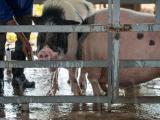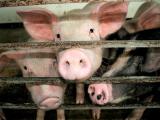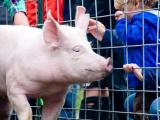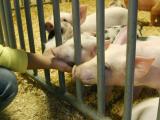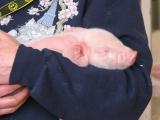Oct 2, 2012 (CIDRAP News) – Eleven of 16 hospitalized US cases of variant H3N2 (H3N2v) swine-origin influenza this past summer occurred in Ohio, and 10 of those were in children, according to a report that also suggests that even healthy people stay away from pigs at fairs to avoid flu infection.
The report also provides details on the only adult Ohioan who was hospitalized for H3N2v infection—a 61-year-old woman with underlying medical conditions who died.
Writing in Morbidity and Mortality Weekly Report (MMWR) last week, investigators from Ohio and the US Centers for Disease Control and Prevention (CDC) said that 6 of the 11 patients were at increased risk for flu complications because of their age or underlying medical condition.
Four had only indirect contact with pigs—meaning they were nearby but didn't touch them—and one reported no contact, indicating human-to-human transmission. H3N2v was confirmed by real-time reverse-transcription polymerase chain reaction.
Investigators had access to case report forms for 7 of the 11 patients and hospital records for 9. Patients' median age was 6 years, with the youngest being less than 1 year. Eight of the patients were female.
Of the patients who had direct contact with swine, one "might have had direct contact with an ill pig," according to the report.
Six of the patients were considered at high risk for flu complications: Three were younger than 5 years, and three, including the 61-year-old, had underlying medical conditions.
Only one patient received antiviral treatment before admission, and six received oseltamivir (Tamiflu) during hospitalization—four within 48 hoursof admission. One child required supplemental oxygen, and another received humidified air. The woman who died was the only one who needed mechanical ventilation.
The median length of hospital stay was 1 day, with a range of 1 to 3 days.
Two cases profiled
The MMWR article includes detailed case reports for two patients, a 4-year-old girl with asthma who had direct swine contact and the 61-year-old woman. Hers is the only known fatal US H3N2v case.
The 61-year-old began coughing and sneezing on Aug 10, 6 days after spending 4 days at a county fair where she had direct contact with pigs in a swine barn.
Over the next 2 weeks, the woman—who had type 2 diabetes, congestive heart disease, hypertension, and a history of B-cell lymphoma—continued coughing, had a fever, and was treated with antibiotics for a sinus infection.
On Aug 25, she sought emergency department care because of worsening symptoms. She was transferred to a tertiary care center with hemodynamic instability and respiratory distress requiring ventilation. Her condition deteriorated, and she died on Aug 26.
The apparent case of person-to-person transmission occurred in a 6-year-old who had no contact with pigs but whose grandmother works with horses on a farm that also houses swine.
The authors conclude, "These findings reinforce the recommendation for persons at high risk for influenza complications to avoid swine exposure at agricultural fairs this fall. In addition, persons not at high risk for influenza complications who wish to reduce their risk for infection with influenza viruses circulating among pigs also should avoid swine and swine barns at agricultural fairs this fall."
Andrew Bowman, DVM, one of the report's authors, told CIDRAP News, "I would like to emphasize that we cannot rely on visual examination to identify pigs infected with influenza virus A at fairs."
Bowman, with The Ohio State University (OSU) College of Veterinary Medicine, added that subclinical influenza A infections are common in pigs at fairs, pointing to a study he and his colleagues published yesterday in Emerging Infectious Diseases (see related CIDRAP News story) after testing pigs in Ohio.
The same journal published similar results in August from scientists who tested pigs at the Minnesota State Fair during the 2009 H1N1 pandemic.
Avoiding contact with pigs
The sentence in the report advising people without risk factors to avoid swine barns if they want to avoid the flu caught the attention of influenza expert Michael Osterholm, PhD, MPH, who in August had recommended that fairs shut down swine barns.
"It reflects that [the authors] generally recognize that we must consider what we can do to lessen the risks imposed at the human-animal interface regarding influenza transmission," said Osterholm, director of the University of Minnesota's Center for Infectious Disease Research and Policy, publisher of CIDRAP News. "Because once it's crossed, there's no telling what might happen regarding mutation or reassortment.
"I think it really helps us move toward a very important discussion on fairs and human contact with swine and the risk of moving novel influenza viruses across the animal-human interface. We don't know today if we can alter the impact of the human-animal interface, but I'd rather make that a priority than try to catch up after the fact with developing a pandemic vaccine months later.
"The only way to do that is to reduce the contact that 80 million Americans who attend state and county fairs each year have with pigs. That number far exceeds by many fold the number of people contacting pigs in the agriculture industry."
Bernard Easterday, DVM, dean emeritus of the University of Wisconsin-Madison School of Veterinary Medicine, said of the MMWR advice on steering clear of swine barns to avoid infection, "It seems to me to be a prudent thing to do."
Bowman added, "Good personal hygiene practices—hand washing, not eating or drinking in livestock barns, etc—are important components to improving public health in general, but their impact on preventing zoonotic transmission of influenza A viruses at fairs is unknown.
"We will be working to investigate strategies that can be used to minimize the risk of intra- and interspecies transmission of influenza A viruses at fairs. In the interim, all persons wishing to decrease their risk of infection can do so by limiting their exposure."
Bowman said that next year OSU researchers plan to increase surveillance and risk-assessment efforts "so we can provide regulatory officials with the scientific data to make evidence-based recommendations to protect animal and public health."
See also:
Sep 28 MMWR report
Oct 1 Emerg Infect Dis study
Aug 15 CIDRAP News story "Study finds flu in healthy-looking pigs at state fairs"
Aug 21 CIDRAP News story "H3N2v infections spark debate about barring pigs from fairs"
